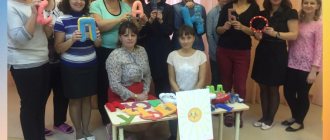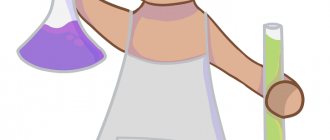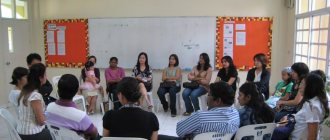Workshop for teachers “Organization of story-based games in kindergarten”
• reporting any new fact during the game.
Teacher-observer,
if necessary
(senior preschool age
) assistant.
The task is to develop the skills to build a plot together, understand your partner in the game, and coordinate your actions with other participants in the game:
• advice (for example, remind that the main role can be performed alternately);
• an appropriate question before the start of the game;
• assistance in combining several plots into one comprehensive game (with hints, hints, advice, questions, suggestions, not at all intrusive)
• direct intervention in the game if it has acquired a negative direction (the teacher, in a playful way, pushes for ways out of the current situation).
Creation of a developing subject-game environment
In order for children’s play activity to develop successfully, it is first necessary to take care of its saturation. All types of toys in a group should be selected taking into account the age, interests of children and the goals of their development, education, and training.
Teachers of early and junior preschool age groups must constantly replenish and change situations in play areas. There should be a large variety of toys and in several copies. At this age, toys are the starting point of organizing role-playing games.
In groups for children of senior preschool age, it is no longer toys that determine the content of the game, but, on the contrary, the content of the game determines the choice of toys. Older preschoolers are able to adapt various substitute objects for play, while showing extraordinary ingenuity. Therefore, in groups for children of senior preschool age there should not be a large number of toys; their excess muffles the interest of children and limits the possibilities of creative imagination.
The teacher can help children understand that some substitute objects can easily be turned into any attribute needed for the game during the game. Let's say, colored paper - it's easy to tear it into small pieces (salad, roll it into a tube (thermometer, draw a pattern on it (tablecloth, napkin, rug). Each such thing is valuable because it is made by the child himself. Therefore, it would be appropriate in every group have, for example, a box with waste material, and in it various boxes, scraps of fabric, sticks, ribbons, bows, pieces of fur and other material that may be required in the game. It is important that the substitute object resembles the depicted object in general contours or in some way then a typical property, a characteristic detail.
If younger preschoolers usually get acquainted with these objects with the help of a teacher who shows ways to play with them and sequential actions, then children already independently use the conditional play environment to develop the plot, while defining their roles. Using substitute objects, children go beyond traditional games and increasingly reflect the phenomena of the surrounding reality.
Games for health Workshop for teachers
Speech by a physical education instructor at a workshop for teachers
"Games that heal"
The form of the speech is a presentation showing practical material. The games presented in the presentation are played with teachers.
Note: For the convenience of completing practical tasks, seminar participants are dressed in sportswear.
Equipment 4 hoops, balls for 1/2 participants, turntables according to the number of participants or a suspension with balloons, gymnastic mats for performing sitting-lying exercises.
At the end of the presentation, the instructor offers participants a card index of games and exercises for the prevention of diseases in preschoolers. LOOKS LIKE THAT:
Description of the slides
Slide1 Games that heal. Seminar-workshop for Tissot teachers: “Movement can replace various medications, but not a single medicine can replace movement” Slide 2 Goal: Increasing the professional competence of educational institution teachers in organizing health-saving work with preschoolers. Objective: To introduce teachers to games and exercises for the prevention of diseases in preschool children. Slide3 Game is the leading activity of a preschool child. Outdoor games teach life situations, help the child get proper development, and strengthen physical health.
A growing body especially needs muscle activity, so insufficient physical activity leads to the development of a number of chronic diseases.
Movement and emotional uplift contribute to a significant increase in the activity of the musculoskeletal, cardiovascular and respiratory systems, due to which the metabolism in the body improves and the functions of various systems and organs are trained accordingly. Slide4 Beautiful posture is one of the indicators of health
REFERENCE Poor posture is a persistent deviation of the body from its normal position. Accompanied by strengthening or smoothing of the physiological curves of the spine
Poor posture is a frequent companion to many chronic diseases, manifested in general functional weakness, hypotonic (reduced tissue tension) state of muscles and ligaments. Defects in posture negatively affect the functioning of the heart, stomach, liver, and kidneys.
The basis for the prevention and treatment of postural disorders is general training of the child’s body. Slide 5 “Games that heal” are aimed at strengthening the musculoskeletal system; strengthening the muscular “corset” of the spine; improvement of respiratory and cardiovascular functions.
In the process of conducting outdoor games, it is necessary to achieve training in skills in holding the head and torso in the correct position, walking correctly (chest forward, shoulder blades slightly pulled together, chin raised). Games for coordination of movements and balance help develop correct posture. Slide6 Game “Space Carousel” In the corners of the hall, groups place four hoops with a diameter of 70-100 cm at a distance of at least 2 m from the wall. Children are divided into four subgroups. Each person stands on one of the hoops (with the middle part of the foot), thus forming a circle. Everyone joins hands. At the signal, children begin to move along the hoops to the right side with side steps - the carousel rotates. When the whistle blows, everyone runs to the opposite side, occupying other carousels. The first team to hold hands and stand on the hoop wins. Slide7 “Obedient ball” Children, two by two, lie on their backs in one line, head to head. One has the ball sandwiched between his feet, he raises his legs behind his head, takes the ball from his partner with the other hand, pinches it with his feet, and passes it to the first. What an obedient ball! Hook it between your feet. Turn around and look back. Ball, don't roll to the floor! If you put several children in one line, you can lead a competitor. Such games will not only help reinforce the skill of correct posture, but will also increase the child’s interest in activities. Slide8 Prevention of flat feet
REFERENCE Flat feet is a disease expressed in deformation (flattening, lowering) of the arch of the foot. It occurs when the load on the arches of the feet is excessive. The ligaments and muscles of the foot are overstrained, stretched, lose their springy properties, the arches of the feet drop, flatten - flat feet occur.
Recently, flat feet have become increasingly common in preschool children. Flat feet negatively affects the general condition of the child and can lead to various serious diseases. The foot is a support, the foundation of the whole organism. Changing the shape of the foot causes increased fatigue and pain when walking, provokes a “shaking” of the bones of the lower spine, so very often it is the cause of postural disorders. Slide9 From the moment a child begins to stand on his feet, it is necessary to strengthen the muscular-ligamentous apparatus of the lower leg and foot, and develop the skill of proper walking (without spreading his toes).
Active formation of the function of the child’s musculoskeletal system occurs up to 6 years of age. After this, flat feet are much more difficult to cure. It is for this reason that it is so important to prevent flat feet in preschoolers.
Slide 10 “Games that heal” Aimed at developing and strengthening the muscular-ligamentous apparatus of the lower leg and foot Forming the skill of correct walking and posture
Attention! All exercises and games are carried out without shoes. Slide 11 “To a watering hole” Children walk along ribbed paths or between two cords, changing types of walking according to the text, and say: On a hot day along a forest path (regular walking) The animals went to a watering hole. A baby elephant stomped behind the mother elephant. (Walking with long strides.) A little fox crept behind the mother fox. (Walking on toes.) The hedgehog was rolling after its mother. (Walking on heels.) A bear cub walked behind the mother bear. (Walking on the outer sides of the feet.) (A. Ekimtsev) Slide 12 “Rain” Hoops with a diameter of 50 cm are laid out along the walls of the hall (group) on the floor. Children line up in a circle, opening with their arms outstretched to the sides. They walk to the right, changing types of walking as directed by an adult: on their toes, heels, outer sides of their feet, raising their knees high, crossing, rolling from heel to toe, etc. At the signal “Rain!” everyone stops and says in unison: It’s raining, and we need to run home! Each player runs to the hoop and stands on its rim, moving along it sideways (right and left) with side steps. Slide 13 Prevention of respiratory diseases REFERENCE Respiratory diseases are a group of diseases of the respiratory tract and lungs that are caused by suboptimal functionality of the immune system. Respiratory diseases occupy first place in the structure of general morbidity among children. Rhinitis, pharyngitis, sinusitis, tonsillitis, laryngitis, tracheitis, bronchitis - these beautiful names hide respiratory diseases. To prevent diseases of the upper respiratory tract, it is necessary to regularly monitor the microclimate in rooms where children are present most of the time. Slide14 Measures for the prevention of upper respiratory tract diseases: carry out wet cleaning in a timely manner; observe the ventilation regime; avoid drafts; monitor hygiene; carry out hardening procedures; Provide your child with healthy and nutritious nutrition. Slide 15 Restoring the health of children who have suffered from upper respiratory tract diseases occurs especially effectively in the fresh air. For this, it is important to take daily walks. Attention! It allows the child to remain in damp and cold air for a long time and general hypothermia of the body. Slide 16 “Games that heal” are aimed at training the respiratory muscles, developing proper nasal breathing; strengthening facial muscles; strengthening the chest muscles Slide 17 “King of the Winds” Material: Pinwheel or ball. Progress of the game. The teacher tells the children: “Once winds gathered from different parts of the world and decided to choose the strongest. They organized a competition to see which wind blows the strongest.” Then the children blow on a pinwheel (whose spinner spins the longest is the winner) or on suspended balloons (whose ball flies higher is the winner). At the leader’s command they blow, and the leader shows how to blow correctly: air is supplied through the nose and exhaled sharply through the mouth. Slide 18 “Inflate the balloon” Game progress. The teacher suggests “blowing up the balloon.” Children should inflate the balloon: spread their arms wide to the sides and take a deep breath of air through their nose, blow it into an imaginary balloon through their mouth “fff...”, slowly bringing their palms together under the balloon. Then, when the teacher claps, the balloon bursts - the children clap their hands. Air comes out of the ball: children say “shhh...”, making a proboscis with their lips and folding their hands on their knees. The balloon is inflated 2-5 times. Slide 19 Prevention of digestive disorders in children REFERENCE Digestive disorders are disorders that arise against the background of pathologies of the motor, secretory, excretory or absorption functions of the digestive tract. One of the most common types of functional disorders is constipation. The most common cause of constipation in children is sluggish, lazy intestines when peristalsis is slow. In this case, it can be stimulated through physical exercises that train the abdominal muscles, diaphragm and pelvic floor, as well as massage and diet. Slide 20 “Games that heal”
aimed at strengthening the abdominal muscles, diaphragm and pelvic floor
Crunches are the main exercises for improving the functioning of the digestive system. Slide21 “Watch” Starting position – sitting on the floor, legs crossed in a Turkish style, hands on your knees. Rock your body now to the right, now to the left, saying “tick-tock.” Repeat 10 times in each direction.
Time flies, telling the children to grow up. The clock whispers like this: Tick-tock! N. Chuprova Slide22 “Snails” Starting position – lying on your back. Alternately pulling the knees towards the stomach. Repeat 10 times with each leg. On the path near the gate, two snails met, and argued a little - Who has the longer horns? It turned out that they are the same length. T. Patrakeeva Slide23 Mental health of children REFERENCE The mental health of a child is his positive mental adaptation to life in society: endurance to stress, resistance to adverse influences.
After suffering illnesses, a child who has been at home with his parents for a long time often finds it difficult to return to the large kindergarten team.
It should be taken into account that the psyche is especially vulnerable in children who are physically weakened from birth, in children who are excitable and often ill. These children urgently need a reliable shield from traumatic situations. Slide24 “Games that heal” are aimed at creating a good mood, developing attention, relieving nervous system tension and fatigue.
Specially organized psychological games help the formation and development of a small personality. Slide 25 “Brownian motion” Participants are invited to actively move around the room to the music. As soon as the music turns off, the presenter suggests joining groups based on some characteristic (for example, eye color, items of clothing, pets, etc.). The task is more fun if the participants are also prohibited from talking. At the end, the leader calls a number (at the end - the number “3” to divide the group into 3 subgroups), the participants should hold hands and unite into groups consisting of that number of people. Slide 26 “A Minute of Friendship” Children line up in a circle, in the circle the children find a mate, offering their hand to the person standing next to them, pronounce the words together with the teacher: - One palm, two palms. Be friends with me a little. We are friendly guys, friendly, obedient. Turning in pairs one after another, the children walk in a circle. At the teacher's signal: One, two, three - Open your hands! The children open their arms and run around in all directions. At the signal One, two, three - quickly run into the circle!
Children line up in a circle, the game is repeated Slide 27 Movement is an effective remedy. Physical education classes, physical education minutes, outdoor games, finger gymnastics, outdoor games, sports entertainment, invigorating gymnastics, corrective gymnastics, breathing exercises are a condition for a beneficial, preventive effect on the growing child’s body.




